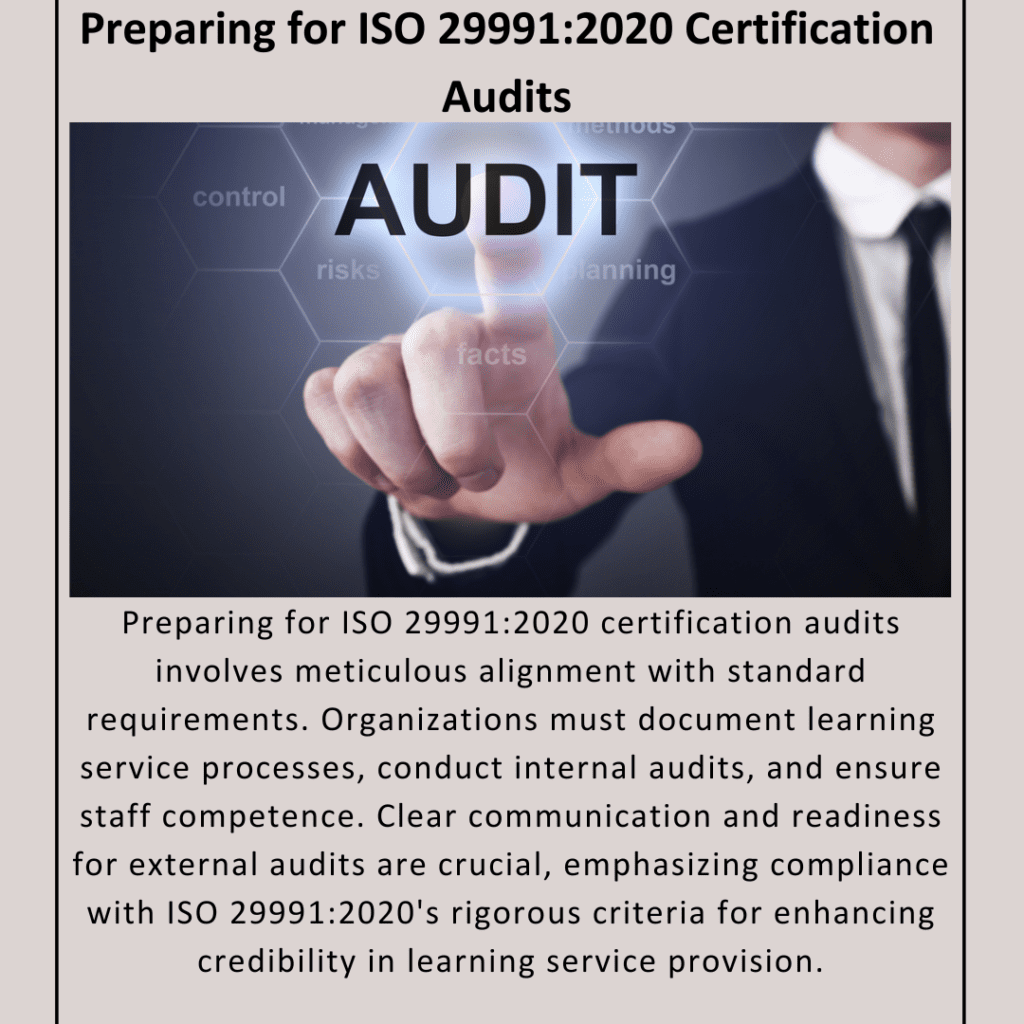Subtotal $0.00

ISO 29991:2020 is a standard specifically designed for learning services outside formal education, aiming to ensure quality and consistency in training and development offerings. Achieving certification under ISO 29991 demonstrates an organization’s commitment to delivering effective learning services that meet international standards of quality management.
Understanding the Certification Process
Before diving into the specifics of preparing for ISO 29991:2020 certification audits, it’s crucial to grasp the overall certification process. The process typically involves several key stages:
Tips for Effective Preparation
Preparing for an ISO 29991:2020 certification audit requires careful planning and execution. Here are essential tips and insights to help organizations navigate this process effectively:
Insights from Organizations
To provide practical insights into preparing for ISO 29991:2020 certification audits, let’s explore how two hypothetical organizations approach the process:
Case Study: Organization A
Organization A is a training institute specializing in professional development courses. In preparation for ISO 29991:2020 certification, they began by conducting a comprehensive gap analysis. This analysis revealed areas where their existing processes aligned well with ISO 29991 requirements and areas needing enhancement, such as learner feedback mechanisms and competency assessments.
With strong support from top management, Organization A allocated dedicated resources to develop and document new procedures and update existing policies. They implemented a phased approach, starting with pilot testing new processes in select departments before full-scale implementation.
Internal audits played a crucial role in their preparation journey. They appointed trained internal auditors who conducted regular audits to monitor progress, identify non-conformities, and recommend corrective actions. These audits helped Organization A refine their processes, address gaps, and ensure compliance readiness.
As the audit date approached, Organization A conducted mock audits to simulate the certification audit experience. This exercise allowed them to fine-tune their documentation, familiarize staff with audit procedures, and build confidence in their readiness for the external audit.
Case Study: Organization B
Organization B, a multinational corporate training provider, embarked on ISO 29991:2020 certification to standardize their global learning services. They initiated the process by establishing a cross-functional team comprising representatives from training, quality assurance, and compliance departments.
Engagement of top management was pivotal in securing necessary resources and aligning organizational priorities with ISO 29991 requirements. Organization B conducted a thorough gap analysis across their global operations, identifying variations in practices and regulatory requirements across different regions.
To streamline implementation, they developed a centralized framework of policies and procedures that could be adapted to regional nuances while ensuring compliance with ISO 29991 standards. Regular communication and training sessions were conducted to build awareness and ensure consistent implementation across all branches.
Internal audits were conducted periodically across their regional offices, facilitated by trained auditors who reported directly to the certification project team. Non-conformities identified during audits were promptly addressed through corrective actions and continuous improvement initiatives.
In preparation for the certification audit, Organization B collaborated closely with their chosen certification body, providing them with access to comprehensive documentation and records of internal audits. They facilitated open communication and transparency throughout the audit process, which culminated in successful ISO 29991:2020 certification for their global operations.
Conclusion
Preparing for ISO 29991:2020 certification audits requires proactive planning, diligent implementation, and continuous improvement efforts. By engaging top management, allocating resources, conducting thorough gap analyses, developing robust documentation, and conducting regular internal audits, organizations can enhance their readiness and streamline the certification process. Effective preparation not only ensures compliance with ISO 29991 standards but also fosters a culture of quality and continuous improvement within the organization.